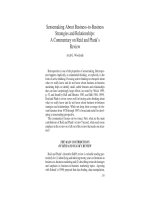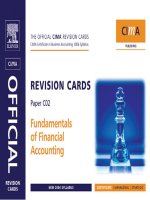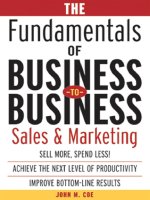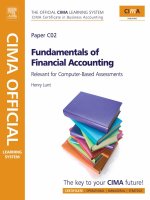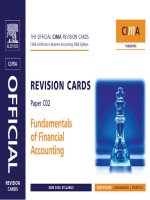CIMA c3 ELSEVIER fundamentals of business mathematics
Bạn đang xem bản rút gọn của tài liệu. Xem và tải ngay bản đầy đủ của tài liệu tại đây (5.35 MB, 569 trang )
CIMA Official
Learning System
Relevant for
Computer-Based Assessments
C3 – Fundamentals
of Business
Mathematics
CIMA Certificate in
Business Accounting
Graham Eaton
CIMA Publishing is an imprint of Elsevier
Linacre House, Jordan Hill, Oxford OX2 8DP, UK
30 Corporate Drive, Suite 400, Burlington, MA 01803, USA
First edition 2008
Copyright © 2009 Elsevier Ltd. All rights reserved
No part of this publication may be reproduced, stored in a retrieval system
or transmitted in any form or by any means electronic, mechanical, photocopying,
recording or otherwise without the prior written permission of the publisher
Permissions may be sought directly from Elsevier’s Science & Technology Rights
Department in Oxford, UK: phone (ϩ44) (0) 1865 843830; fax (ϩ44) (0) 1865 853333;
e-mail: Alternatively you can visit the Science and Technology Books
website at www.elsevierdirect.com/rights for further information
Notice
No responsibility is assumed by the publisher for any injury and/or damage to persons
or property as a matter of products liability, negligence or otherwise, or from any use
or operation of any methods, products, instructions or ideas contained in the material herein.
British Library Cataloguing in Publication Data
A catalogue record for this book is available from the British Library
Library of Congress Cataloguing in Publication Data
A catalogue record for this book is available from the Library of Congress
978-1-85617-783-2
For information on all CIMA publications visit
our website at www.elsevierdirect.com
Typeset by Macmillan Publishing Solutions
(www.macmillansolutions.com)
Printed and bound in Italy
09 10 11
11 10 9 8 7 6 5 4 3 2 1
Contents
The CIMA Learning system
How to use your CIMA Learning System
Study technique
Computer-Based Assessments
Fundamentals of Business Mathematics and Computer-Based Assessments
Learning outcomes and indicative syllabus content
Mathematical Tables
1
Basic Mathematics
1.1
1.2
1.3
1.4
1.5
1.6
1.7
1.8
1.9
1.10
1.11
1.12
1.13
1.14
1.15
1.16
1.17
Learning Outcomes
Introduction
Mathematical operations and brackets
Different types of numbers
Rounding
1.4.1 Rounding to the nearest whole number
1.4.2 Significant figures
1.4.3 Decimal places
1.4.4 Rounding up or rounding down
Powers and roots
1.5.1 Definitions
Mathematical operations in Excel
1.6.1 Rounding numbers in Excel
Variables and functions
Formulae
Exponential numbers
Solving equations
1.10.1 Linear equations with only one variable
1.10.2 Quadratic equations with only one variable
1.10.3 Simultaneous linear equations
Manipulating inequalities
Percentages and ratios
Accuracy and approximation
Errors from rounding
Using Excel to produce graphs of Linear and Quadratic Equations
1.15.1 Producing a single linear equation in Excel
1.15.2 Drawing multiple equations on a single graph
1.15.3 Single quadratic equation
1.15.4 Two quadratic equations on one graph
Using Excel to produce the graph of a hyperbola
Summary
Revision Questions
Solutions to Revision Questions
iii
ix
ix
xi
xii
xiii
xiv
xix
1
3
3
3
4
5
5
5
6
6
7
7
8
8
10
11
13
14
14
15
16
18
19
20
21
21
21
22
23
24
25
26
27
33
iv
FUNDAMENTALS OF BUSINESS MATHEMATICS C3
CONTENTS
2
Obtaining Data
Learning Outcomes
2.1 Introduction
2.1.1 The difference between information and data
2.2 Primary data: sampling
2.3 Probability sampling methods
2.3.1 Simple random sampling
2.3.2 Stratified random sampling
2.4 Other sampling methods
2.5 Multistage sampling
2.6 Secondary data: sources
2.7 Questionnaires
2.8 Contact with respondents
2.9 Importing data to Excel
2.9.1 Importing data from Word
2.9.2 Using the Excel Text to Columns feature
2.10 Summary
Revision Questions
Solutions to Revision Questions
3
Presentation of Data
3.1
3.2
3.3
3.4
3.5
3.6
3.7
3.8
3.9
3.10
3.11
3.12
3.13
3.14
Learning Outcomes
Introduction
Linear graphs
Solving simultaneous linear equations using graphs
Quadratic graphs
Tallying frequency distributions
Discrete and continuous variables
Cumulative frequency distribution
Histograms and ogives
Pie charts
Bar charts
3.10.1 Creating Bar charts using Excel
Tabulation
Pareto analysis – The 80-20 rule
Using spreadsheets to produce histograms, ogives and pie charts
3.13.1 Creating a histogram in Excel
3.13.2 Creating an ogive in Excel
3.13.3 Creating a Pie chart in Excel
Summary
Readings
Revision Questions
Solutions to Revision Questions
39
41
41
42
43
44
44
44
46
47
48
48
49
50
50
51
52
53
59
63
65
65
65
70
71
72
75
76
78
85
87
90
95
96
98
98
101
102
103
105
109
117
v
125
127
127
127
131
135
137
139
139
140
142
144
145
148
150
150
152
153
153
155
157
161
162
165
169
179
CONTENTS
4
FUNDAMENTALS OF BUSINESS MATHEMATICS
Descriptive Statistics
4.1
4.2
4.3
4.4
4.5
4.6
4.7
4.8
4.9
4.10
4.11
4.12
4.13
4.14
4.15
4.16
Learning Outcomes
Introduction
The arithmetic mean
The median
The mode
A comparison of the three averages
Measures of spread
The range
The interquartile range; the quartile deviation
Deciles
The mean absolute deviation
The standard deviation
The coefficient of variation
A comparison of the measures of spread
Descriptive statistics using Excel
A practical example of descriptive statistical analysis using Excel
4.15.1 The questionnaire
4.15.2 Data capture
4.15.3 Preliminary analysis
4.15.4 Descriptive statistics
4.15.5 Worked Example Conclusions
Summary
Readings
Revision Questions
Solutions to Revision Questions
5 Index Numbers
5.1
5.2
5.3
5.4
5.5
5.6
5.7
5.8
5.9
5.10
5.11
5.12
5.13
5.14
5.15
Learning Outcomes
Introduction
Definitions
Interpretation of index numbers
Choice of base year
Change of base year
Combining series of index numbers
Chain-base index numbers
Composite index numbers
Relative price indices
Aggregative price indices
Choice of base weighting or current weighting
Quantity indices
The construction of the UK retail price index
Using the RPI
Summary
Readings
Revision Questions
Solutions to Revision Questions
185
187
187
187
188
189
190
191
192
194
196
198
199
200
202
202
206
207
209
217
vi
FUNDAMENTALS OF BUSINESS MATHEMATICS C3
CONTENTS
6
Financial Mathematics
6.1
6.2
6.3
6.4
6.5
6.6
6.7
6.8
6.9
6.10
6.11
6.12
6.13
6.14
6.15
6.16
Learning Outcomes
Introduction
Simple interest
Compound interest
Equivalent rates of interest
Depreciation
More complex investments
Geometric progressions
Present values
Net present values – practical examples
Problems using NPV in practice
Annuities
PV of a perpetuity
Loans and mortgages
Internal rate of return
Financial functions in Excel
6.15.1 The investment reports
Summary
Readings
Revision Questions
Solutions to Revision Questions
7
Correlation and Regression
7.1
7.2
7.3
7.4
7.5
7.6
7.7
7.8
7.9
7.10
7.11
7.12
7.13
Learning Outcomes
Introduction
Correlation
Pearson’s correlation coefficient
Interpreting correlation coefficients
Rank correlation: Spearman’s coefficient
Which correlation coefficient to use
Regression
The least-squares criterion
Interpreting a and b
Forecasting
Which variable to denote by y
Judging the validity of forecasts
Summary
Revision Questions
Solutions to Revision Questions
8
Time Series
8.1
8.2
Learning Outcomes
Introduction
Components and models of time series
223
225
225
225
227
228
230
231
233
234
236
239
239
241
242
243
246
246
248
251
253
263
271
273
273
274
278
279
280
282
282
283
286
287
289
290
292
293
301
307
309
309
309
FUNDAMENTALS OF BUSINESS MATHEMATICS
Forecasting linear trends
Forecasting seasonal components
Producing the final forecast
Seasonal adjustment
Moving average trends
Other types of data
Judging the validity of forecasts
Computations involving the additive model
Summary
Readings
Revision Questions
Solutions to Revision Questions
9
Probability
9.1
9.2
9.3
9.4
9.5
9.6
9.7
9.8
9.9
9.10
9.11
9.12
9.13
9.14
9.15
Learning Outcomes
Introduction
Definitions of probability
Addition rules of probability
The probability of opposites
The multiplication rules of probability
More conditional probabilities
Discrete probability distributions; expectations
Expectation and decision-making
Limitations of this approach
Characteristics of the normal distribution
Use of the tables of normal distribution
Further normal distribution examples
Venn diagrams
9.13.1 Using Venn diagrams to assist with probability
Uncertainty and risk
Summary
Revision Questions
Solutions to Revision Questions
10
Spreadsheet Skills using Excel
10.1
10.2
10.3
10.4
Learning Outcomes
Introduction
Spreadsheet terminology
10.2.1 Workbooks and Worksheets
10.2.2 Cells
A note on macros and application development
Getting started with Excel
10.4.1 Workbooks of files
10.4.2 Worksheets
10.4.3 Scroll bars
312
314
317
318
319
322
324
325
328
329
331
339
345
347
347
348
349
351
351
355
356
358
361
362
363
368
370
371
372
375
377
385
393
395
395
396
396
396
396
397
397
397
398
CONTENTS
8.3
8.4
8.5
8.6
8.7
8.8
8.9
8.10
8.11
vii
CONTENTS
viii
FUNDAMENTALS OF BUSINESS MATHEMATICS C3
10.5
10.6
10.7
10.8
10.9
10.10
10.11
10.12
10.13
10.14
10.15
10.16
10.4.4 Status bar
10.4.5 Toolbars
Good spreadsheet design
Getting started
10.6.1 Problems with this spreadsheet
10.6.2 Positive aspects of this spreadsheet
Ownership and version
10.7.1 Problems with this spreadsheet
10.7.2 Positive aspects of this spreadsheet
Formatting
10.8.1 Problems with this spreadsheet
10.8.2 Positive aspects of this spreadsheet
Documentation
Minimising absolute values
10.10.1 Problems with this spreadsheet
Control checks for auditing
Charts
Tips for larger plans
Templates
10.14.1 Data input forms
The use of spreadsheets by management accountants
Summary
Preparing for the Assessment
Revision technique
Format of the assessment
Revision Questions
Solutions to Revision Questions
398
398
398
399
399
399
399
400
400
400
400
401
402
403
404
405
406
406
407
408
409
410
411
413
414
417
453
Mock Assessment 1
481
Mock Assessment 2
505
Index
535
The CIMA
Learning System
How to use your CIMA Learning System
This Fundamentals of Business Mathematics Learning System has been devised as a resource
for students attempting to pass their CIMA computer-based assessments, and provides:
●
●
●
●
a detailed explanation of all syllabus areas;
extensive ‘practical’ materials;
generous question practice, together with full solutions;
a computer-based assessments preparation section, complete with computer-based assessments standard questions and solutions.
This Learning System has been designed with the needs of home-study and distancelearning candidates in mind. Such students require very full coverage of the syllabus topics,
and also the facility to undertake extensive question practice. However, the Learning
System is also ideal for fully taught courses.
This main body of the text is divided into a number of chapters, each of which is organised on the following pattern:
●
●
●
●
Detailed learning outcomes expected after your studies of the chapter are complete. You
should assimilate these before beginning detailed work on the chapter, so that you can
appreciate where your studies are leading.
Step-by-step topic coverage. This is the heart of each chapter, containing detailed explanatory text supported where appropriate by worked examples and exercises. You should
work carefully through this section, ensuring that you understand the material being
explained and can tackle the examples and exercises successfully. Remember that in
many cases knowledge is cumulative: if you fail to digest earlier material thoroughly, you
may struggle to understand later chapters.
Activities. Some chapters are illustrated by more practical elements, such as comments
and questions designed to stimulate discussion.
Question practice. The test of how well you have learned the material is your ability to
tackle exam-standard questions. Make a serious attempt at producing your own answers,
but at this stage do not be too concerned about attempting the questions in computerbased assessments conditions. In particular, it is more important to absorb the material
thoroughly by completing a full solution than to observe the time limits that would
apply in the actual computer-based assessments.
ix
THE CIMA LEARNING SYSTEM
x
FUNDAMENTALS OF BUSINESS MATHEMATICS C3
●
Solutions. Avoid the temptation merely to ‘audit’ the solutions provided. It is an illusion
to think that this provides the same benefits as you would gain from a serious attempt
of your own. However, if you are struggling to get started on a question you should read
the introductory guidance provided at the beginning of the solution, where provided,
and then make your own attempt before referring back to the full solution.
Having worked through the chapters you are ready to begin your final preparations for the
computer-based assessments. The final section of the CIMA Learning System provides you
with the guidance you need. It includes the following features:
●
●
●
●
●
●
A brief guide to revision technique.
A note on the format of the computer-based assessments. You should know what
to expect when you tackle the real computer-based assessments, and in particular the
number of questions to attempt.
Guidance on how to tackle the computer-based assessments itself.
A table mapping revision questions to the syllabus learning outcomes allowing you to
quickly identify questions by subject area.
Revision questions. These are of computer-based assessments standard and should be tackled in computer-based assessments conditions, especially as regards the time allocation.
Solutions to the revision questions.
Two mock computer-based assessments. You should plan to attempt these just before the
date of the real computer-based assessments. By this stage your revision should be complete and you should be able to attempt the mock computer-based assessments within the
time constraints of the real computer-based assessments.
If you work conscientiously through the CIMA Learning System according to the guidelines above you will be giving yourself an excellent chance of success in your computerbased assessments. Good luck with your studies!
Guide to the Icons used within this Text
Key term or definition
Exam tip or topic likely to appear in the computer-based assessments
Exercise
Question
Solution
Comment or Note
Discussion points
Equations to learn
FUNDAMENTALS OF BUSINESS MATHEMATICS
xi
Passing exams is partly a matter of intellectual ability, but however accomplished you are
in that respect you can improve your chances significantly by the use of appropriate study
and revision techniques. In this section we briefly outline some tips for effective study during the earlier stages of your approach to the computer-based assessments. Later in the text
we mention some techniques that you will find useful at the revision stage.
THE CIMA LEARNING SYSTEM
Study technique
Planning
To begin with, formal planning is essential to get the best return from the time you spend
studying. Estimate how much time in total you are going to need for each paper you are
studying for the Certificate in Business Accounting. Remember that you need to allow
time for revision as well as for initial study of the material. The amount of notional study
time for any paper is the minimum estimated time that students will need to achieve the
specified learning outcomes set out below. This time includes all appropriate learning
activities, for example, face-to-face tuition, private study, directed home study, learning in
the workplace, revision time, etc. You may find it helpful to read Better Exam Results: a
Guide for Business and Accounting Students by S. A. Malone, Elsevier, ISBN: 075066357X.
This book will provide you with proven study techniques. Chapter by chapter it covers the
building blocks of successful learning and examination techniques.
The notional study time for the Certificate in Business Accounting paper
Fundamentals of Business Mathematics is 130 hours. Note that the standard amount
of notional learning hours attributed to one full-time academic year of approximately 30
weeks is 1,200 hours.
By way of example, the notional study time might be made up as follows:
Hours
Face-to-face study: up to
Personal study: up to
‘Other’ study – e.g. learning in the workplace, revision, etc.: up to
40
65
25
130
Note that all study and learning-time recommendations should be used only as a guideline
and are intended as minimum amounts. The amount of time recommended for face-to-face
tuition, personal study and/or additional learning will vary according to the type of course
undertaken, prior learning of the student, and the pace at which different students learn.
Now split your total time requirement over the weeks between now and the exam. This
will give you an idea of how much time you need to devote to study each week. Remember
to allow for holidays or other periods during which you will not be able to study (e.g.
because of seasonal workloads).
With your study material before you, decide which chapters you are going to study in
each week, and which weeks you will devote to revision and final question practice.
Prepare a written schedule summarising the above – and stick to it!
The amount of space allocated to a topic in the Learning System is not a very good
guide as to how long it will take you. For example, the material relating to Section A ‘Basic
Mathematics’ and Section C ‘Summarising and Analysing Data’ both account or 15% of
THE CIMA LEARNING SYSTEM
xii
FUNDAMENTALS OF BUSINESS MATHEMATICS C3
the syllabus, but the latter has more pages because there are more illustrations, which take
up more space. The syllabus weighting is the better guide as to how long you should spend
on a syllabus topic. It is essential to know your syllabus. As your course progresses you will
become more familiar with how long it takes to cover topics in sufficient depth. Your timetable may need to be adapted to allocate enough time for the whole syllabus.
Tips for effective studying
1. Aim to find a quiet and undisturbed location for your study, and plan as far as possible
to use the same period of time each day. Getting into a routine helps to avoid wasting time. Make sure that you have all the materials you need before you begin so as to
minimise interruptions.
2. Store all your materials in one place, so that you do not waste time searching for items
around your accommodation. If you have to pack everything away after each study
period, keep them in a box, or even a suitcase, which will not be disturbed until the
next time.
3. Limit distractions. To make the most effective use of your study periods you should
be able to apply total concentration, so turn off all entertainment equipment, set your
phones to message mode, and put up your ‘do not disturb’ sign.
4. Your timetable will tell you which topic to study. However, before diving in and becoming engrossed in the finer points, make sure you have an overall picture of all the areas
that need to be covered by the end of that session. After an hour, allow yourself a short
break and move away from your Learning System. With experience, you will learn to
assess the pace you need to work at.
5. Work carefully through a chapter, making notes as you go. When you have covered a
suitable amount of material, vary the pattern by attempting a practice question. When
you have finished your attempt, make notes of any mistakes you made, or any areas
that you failed to cover or covered only skimpily.
6. Make notes as you study, and discover the techniques that work best for you. Your
notes may be in the form of lists, bullet points, diagrams, summaries, ‘mind maps’, or
the written word, but remember that you will need to refer back to them at a later date,
so they must be intelligible. If you are on a taught course, make sure you highlight any
issues you would like to follow up with your lecturer.
7. Organise your notes. Make sure that all your notes, calculations etc can be effectively
filed and easily retrieved later.
Computer-Based Assessments
CIMA uses computer-based assessments (CBAs) for all subjects for the Certificate in
Business Accounting. The website says
Objective questions are used. The most common type is ‘multiple choice’, where you have to choose the correct answer from a list of possible answers, but there are a variety of other objective question types that can
be used within the system. These include true/false questions, matching pairs of text and graphic, sequencing
and ranking, labelling diagrams and single and multiple numeric entry.
Candidates answer the questions by either pointing and clicking the mouse, moving objects around the
screen, typing numbers, or a combination of these responses. Try the online demo at aglobal
.com to see how the technology works.
FUNDAMENTALS OF BUSINESS MATHEMATICS
In every chapter of this Learning System we have introduced these types of questions
but obviously we have to label answers A, B, C etc. rather than using click boxes. For
convenience, we have retained quite a lot of questions where an initial scenario leads to
a number of sub-questions. There will be questions of this type in the CBA but they will
rarely have more than three sub-questions. In all such cases the answer to one part does
not hinge upon a prior answer.
Fundamentals of Business Mathematics and
Computer-Based Assessments
The computer-based assessments for Fundamentals Business Mathematics is a 2-hour
computer-based assessments comprising 45 compulsory questions, with one or more parts.
Single part questions are generally worth 1–2 marks each, but two and three part questions
may be worth 4 or 6 marks. There will be no choice and all questions should be attempted
if time permits. CIMA are continuously developing the question styles within the CBA
system and you are advised to try the on-line website demo at www.cimaglobal.com, to
both gain familiarity with assessment software and examine the latest style of questions
being used.
Fundamentals of Business Mathematics
Syllabus outline
The Syllabus comprises:
Topic and study weighting
A
B
C
D
E
F
G
Basic Mathematics
Probability
Summarising and Analysing Data
Inter-relationships between variables
Forecasting
Financial Mathematics
Spreadsheets
15%
15%
15%
15%
15%
15%
10%
Learning Aims
This syllabus aims to test the candidate’s ability to:
●
●
●
●
●
demonstrate the use of basic mathematics, including formulae and ratios;
identify reasonableness in the calculation of answers;
demonstrate the use of probability where risk and uncertainty exist;
apply techniques for summarising and analysing data;
calculate correlation coefficients for bivariate data and apply the technique of simple
regression analysis;
THE CIMA LEARNING SYSTEM
The CBA system can ensure that a wide range of the syllabus is assessed, as a pre-determined number
of questions from each syllabus area (dependent upon the syllabus weighting for that particular area) are
selected in each assessment.
xiii
THE CIMA LEARNING SYSTEM
xiv
FUNDAMENTALS OF BUSINESS MATHEMATICS C3
●
●
●
demonstrate techniques used for forecasting;
apply financial mathematical techniques;
apply spreadsheets to facilitate the presentation of data, analysis of univariate and bivariate data and use of formulae.
Assessment strategy
There will be a computer-based assessments of 2 hours duration, comprising 45 compulsory questions, each with one or more parts.
A variety of objective test question styles and types will be used within the assessment.
Learning outcomes and indicative syllabus
content
A
Basic Mathematics – 15%
Learning Outcomes
On completion of their studies students should be able to:
(i) demonstrate the order of operations in formulae, including brackets, powers and
roots;
(ii) calculate percentages and proportions;
(iii) calculate answers to appropriate number of decimal places or significant figures;
(iv) solve simple equations, including two variable simultaneous equations and quadratic
equations;
(v) prepare graphs of linear and quadratic equations.
Indicative syllabus content
●
●
●
●
●
Use of formulae, including negative powers as in the formula for the learning curve.
Percentages and ratios.
Rounding of numbers.
Basic algebraic techniques and solution of equations, including simultaneous equations
and quadratic equations.
Manipulation of inequalities.
B
Probability – 15%
Learning outcomes
On completion of their studies students should be able to:
(i)
(ii)
(iii)
(iv)
(v)
calculate a simple probability;
demonstrate the addition and multiplication rules of probability;
calculate a simple conditional probability;
calculate an expected value;
demonstrate the use of expected value tables in decision making;
FUNDAMENTALS OF BUSINESS MATHEMATICS
Indicative syllabus content
The relationship between probability, proportion and percent.
Addition and multiplication rules in probability theory.
Venn diagrams.
Expected values and expected value tables.
Risk and uncertainty.
●
●
●
●
●
C
Summarising and Analysing Data – 15%
Learning Outcomes
On completion of their studies students should be able to:
(i)
(ii)
(iii)
(iv)
(v)
(vi)
(vii)
(viii)
(ix)
(x)
explain the difference between data and information;
identify the characteristics of good information;
tabulate data and prepare histograms;
calculate for both ungrouped and grouped data: arithmetic mean, median, mode,
range, variance, standard deviation and coefficient of variation;
explain the concept of a frequency distribution;
prepare graphs/diagrams of normal distribution, explain its properties and use tables
of normal distribution;
apply the Pareto distribution and the ‘80:20 rule’;
explain how and why indices are used;
calculate indices using either base or current weights;
apply indices to deflate a series.
Indicative syllabus content
●
●
●
●
●
●
●
Data and information.
Tabulation of data.
Graphs and diagrams: scatter diagrams, histograms, bar charts and ogives.
Summary measures of central tendency and dispersion for both grouped and ungrouped
data.
Frequency distributions.
Normal distribution, the Pareto distribution and ‘80:20 rule’.
Index numbers.
D
Inter-relationships between Variables – 15%
Learning outcomes
On completion of their studies students should be able to:
(i) prepare a scatter diagram;
(ii) calculate the correlation coefficient and the coefficient of determination between two
variables;
THE CIMA LEARNING SYSTEM
(vi) explain the limitations of expected values;
(vii) explain the concepts of risk and uncertainty.
xv
THE CIMA LEARNING SYSTEM
xvi
FUNDAMENTALS OF BUSINESS MATHEMATICS C3
(iii) calculate the regression equation between two variables;
(iv) apply the regression equation to predict the dependent variable, given a value of the
independent variable.
Indicative syllabus content
●
●
Scatter diagrams and the correlation coefficient
Simple linear regression
E
Forecasting – 15%
Learning outcomes
On completion of their studies students should be able to:
(i)
(ii)
(iii)
(iv)
(v)
prepare a time series graph;
identify trends and patterns using an appropriate moving average;
identify the components of a time series model;
prepare a trend equation using either graphical means or regression analysis;
calculate seasonal factors for both additive and multiplicative models and explain
when each is appropriate;
(vi) calculate predicted values, given a time series model;
(vii) identify the limitations of forecasting models.
Indicative syllabus content
●
●
●
●
Time series analysis – graphical analysis.
Trends in time series – graphs, moving averages and linear regression.
Seasonal variations using both additive and multiplicative models.
Forecasting and its limitations.
F
Financial Mathematics – 15%
Learning Outcomes
On completion of their studies students should be able to:
(i)
(ii)
(iii)
(iv)
calculate future values of an investment using both simple and compound interest;
calculate an annual percentage rate of interest given a monthly or quarterly rate;
calculate the present value of a future cash sum using formula and CIMA Tables;
calculate the present value of an annuity and a perpetuity using formula and CIMA
Tables;
(v) calculate loan/mortgage repayments and the value of the loan/mortgage outstanding;
(vi) calculate the future value of regular savings and/or the regular investment needed
to generate a required future sum using the formula for the sum of a geometric
progression;
(vii) calculate the net present value (NPV) and internal rate of return (IRR) of a project
and explain whether and why it should be accepted.
FUNDAMENTALS OF BUSINESS MATHEMATICS
●
●
●
●
●
Simple and compound interest.
Annuities and perpetuities.
Loans and mortgages.
Sinking funds and savings funds.
Discounting to find NPV and IRR and interpretation of NPV and IRR.
G
Spreadsheets – 10%
Learning Outcomes
On completion of their studies students should be able to:
●
●
●
explain the features and functions of spreadsheet software;
explain the use and limitations of spreadsheet software in business;
apply spreadsheet software to the normal work of a Chartered Management Accountant.
Indicative syllabus content
●
●
●
Features and functions of commonly used spreadsheet software: workbook, worksheet,
rows, columns, cells, data, text, formulae, formatting, printing, graphics and macros.
Note: Knowledge of Microsoft Excel type spreadsheet vocabulary/formulae syntax is
required. Formulae tested will be that which is constructed by users rather than preprogrammed formulae.
Advantages and disadvantages of spreadsheet software, when compared to manual analysis and other types of software application packages.
Use of spreadsheet software in the day-to-day work of the Chartered Management
Accountant: budgeting, forecasting, reporting performance, variance analysis, what-if
analysis and discounted cashflow calculations.
THE CIMA LEARNING SYSTEM
Indicative syllabus content
xvii
This page intentionally left blank
Mathematical Tables
LINEAR REGRESSION AND CORRELATION
The linear regression equation of y on x is given by:
Y ϭ a ϩ bX
or
Y Ϫ Y ϭ b( X Ϫ X )
where
bϭ
Covariance(XY ) nΣ XY Ϫ (Σ X )(ΣY )
ϭ
Variance(X )
nΣ X 2 Ϫ (Σ X )2
and
a ϭ Y Ϫ bX
or solve
∑ Y ϭ na ϩ b ∑ X
∑ XY ϭ a ∑ X ϩ b ∑ X 2
Coefficient of Correlation
rϭ
Covariance( XY )
n ∑ XY Ϫ ( ∑ X )( ∑ Y )
ϭ
Var(OX ) ⋅ Var(Y )
(n ∑ X 2 Ϫ ( ∑ X )2 )(n ∑ Y 2 Ϫ ( ∑ Y )2 )
R (rank) ϭ 1 Ϫ
6∑ d 2
n(n 2 Ϫ 1)
FINANCIAL MATHEMATICS
Compound Interest (Values and Sums)
Future Value of S, of a sum X, invested for n periods, compounded at r% interest
S ϭ X [1 ϩ r ]n
Annuity
Present value of an annuity of £1 per annum receivable or payable for n years, commencing in one year, discounted at r% per annum.
PV ϭ
1⎡
1 ⎤
⎢1 Ϫ
⎥
r ⎢⎣
[1 ϩ r ]n ⎥⎦
xix
MATHEMATICAL TABLES
xx
FUNDAMENTALS OF BUSINESS MATHEMATICS C3
Perpetuity
Present value of £1 per annum, payable or receivable in perpetuity, commencing in one
year, discounted at r% per annum.
1
PV ϭ
r
Note that logarithm tables are also available when you sit your assessment.
FUNDAMENTALS OF BUSINESS MATHEMATICS
Z→
MATHEMATICAL TABLES
0
xxi
xxii
MATHEMATICAL TABLES
FUNDAMENTALS OF BUSINESS MATHEMATICS C3
FUNDAMENTALS OF BUSINESS MATHEMATICS
xxiii
MATHEMATICAL TABLES
This page intentionally left blank




